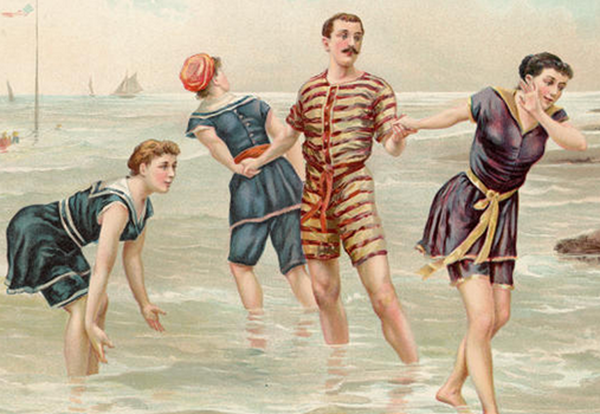
July 13, 2014
 My Summer Reading Is 84 And 95 Years Old
My Summer Reading Is 84 And 95 Years Old


I've been reading a lot of comics this summer, trying to revive the fading spark of my interest in writing about comics on a regular basis. I'm enjoying reading comics for pleasure. I've read a couple of comics summer reading lists in the last couple of weeks. Because these were done as a way of engaging with comics right now, the lists I've seen engage with a variety of new comics right now. That's not a bad thing. It's a solid summer for new fiction in comics form. There's
that beautiful Jaime Hernandez volume, and
the new Tamaki/Tamaki, and AdHouse's wave of comics from under 30s like
Operation Margarine, and that very entertaining gentleman
Pascal Girard. There are even two funny workplace comedies: one with pooping (
Facility Integrity) and one without (
Benson's Cuckoos).
The Eleanor Davis is a beautiful book; that's about to hit and she's already on tour behind it. Jeff Smith will be standing behind his table at San Diego Con
holding an honest-to-god, debut color comic book for sale. I'm forgetting a ton of work.
The two comics I'm reading right now are strip collections. I imagine that's partly nostalgic. One of my fundamental reading experiences was going to the small town near where I spent every summer with my family where, on the days it rained, we were allowed to pick up a paperback book from the local bookseller. I always got
Peanuts books, which I loved. The mystery of which
Peanuts book reprinted which strips and how those overlapped was a mystery to me on par with any rumored-to-be-haunted house to which we kids could pedal our bikes.

By description,
Walt Before Skeezix seems like a book you could skip. Frank King's work in
Gasoline Alley does so well with the father/son relationship and the fears and joys experienced against the backdrop of a changing America that taking that core relationship out seems like a dealbreaker. But there's something about these comics, almost ruthless about car culture as experienced by four men sharing an alleyway (there seem to be more at first but they winnow down
Facts Of Life style pretty quickly), that I've sort of come to love.
King drew in an appealing way, and that makes these comics pleasurable. He knows how to space his characters in a way that takes the eye across the tableau presented in a confident, unassuming way. I don't know enough about early automobiles to know how authoritative those depictions are, but I think the strip is generally handsome, the characters are visually appealing and are fine actors for the broad portrayals demanded of them. The thing I like the most are these one-panel features that King did regularly, where you have a basic situation and each of the four main character riffs on it, in character. There's something almost freakishly comfortable and enjoyable about these strips to me -- I prefer them to the panel-to-panel works about 10 to 1 -- that I'm sort of flummoxed as to why. My guess is that there's something to all comic strips that is basically watching character types pivot around a situation that I find immensely appealing, a mix of pantomime and acting to order that feels like deepening friendships. If someone has a better idea, I hope they let me know.

The other book I'm reading right now is
the LOA collection of one year (plus a little extra) of The Bungle Family. If comic strips from 1920 to 1945 were the popular network television shows of their day,
The Bungle Family is an AMC original series or something from HBO's glory period -- unapologetically aimed at a certain kind of audience and unafraid to hit jarring notes at any moment that suits its creator.
The Bungle Family is basically a ruthless, repeated kicking to the nads that is middle class ambition. The Bungles are slightly horrible people surrounded by even fouler folks, many of whom are relatives. We cheer them on because they are perfectly, unapologetically themselves. With the exception of both doing a joke depicting all 12 months in panel form -- such space they had back then -- Harry J. Tuthill works with a structure that's almost the opposite of early Frank King. The Bungles talk, and talk some more, and move around a bit, but mostly to get to other places they can talk. At least fifty percent of what happens happens off panel. When we get a break from the Bungles talking it's to hear another couple talk about the Bungles.
I think I took to this particular run of
Bungle Family strips more than I have the few sequences I've seen in the past because I came to it from Crockett Johnson's
Barnaby, which is nearly as wordy, and there are enough strips here for me to dive into Tuthill's peculiar rhythms for 10-15 days at a go. Everything that seems extraordinary about the Bungles comes down to their dogged adherence to this completely self-entitled, dimly hopeful view of wealth and ease right around the corner. They never back off; they can't. The message works because the Bungles will never realize what they look like to us, and one becomes desperate to push back from anything that might move us forward so blindly. We laugh at
The Bungle Family in a way we hope no one is laughing at us.
posted 8:00 am PST |
Permalink
Daily Blog Archives
November 2019
October 2019
September 2019
August 2019
July 2019
Full Archives


